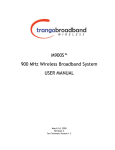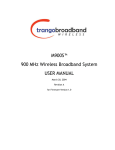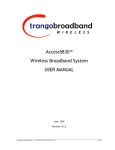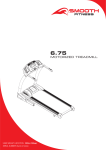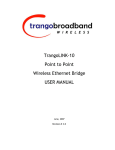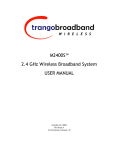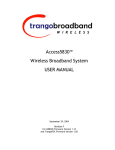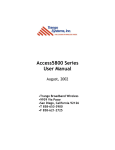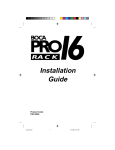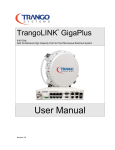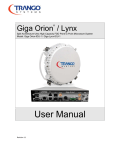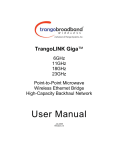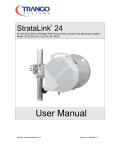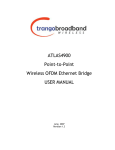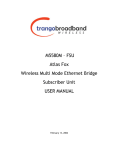Download Access5800 Series User Manual
Transcript
A Access5800 Series User Manual Febuary 26, 2003 •Trango Broadband Wireless •15070 Ave. of Science, Ste. 200 •San Diego, California 92128 •T 858-653-3900 •F 858-621-2725 Trango Broadband Wireless Access5800™ User Manual Copyright 2001 Trango Broadband Wireless, A division of Trango Systems, Inc. No part of this publication may be reproduced in any form without the written permission of the copyright owner. The information in this publication is subject to change without notice. Trango Broadband Wireless shall not be liable for errors contained herein or for incidental or consequential damages in connection with the furnishing, performance, or use of this manual or the equipment it refers to. FCC Information: This device complies with Part 15 of the FCC Rules. Operation is subject to the following two conditions: (1) This device may not cause harmful interference, and (2) this device must accept any interference received, including interference that may cause undesired operation. This equipment has been tested and found to comply with the limits for a Class B digital device, pursuant to Part 15 of the FCC Rules. These limits are designed to provide reasonable protection against harmful interference in a residential installation. This equipment generates, uses, and can radiate radio frequency energy, and if not installed and used in accordance with these instructions, may cause harmful interference to radio communications. However, there is no guarantee that interference will not occur in a particular installation. If this equipment does cause harmful interference to radio or television reception, which can be determined by turning the equipment off and on, the user is encouraged to correct the interference by one of more of the following measures: 1) Reorient the antenna; 2) Increase the separation between the affected equipment and the unit; 3) Connect the affected equipment to an outlet on a different circuit from that whic h the receiver is connected to; 4) Consult the dealer and/or experienced radio/TV technician for help. FCC ID: NCYM5800SBAP60 FCC ID: NCYM5800SBSUEXT CANADA: 2945A12100 IMPORTANT NOTE: Intentional or unintentional changes or modifications not expressly approved by the party responsible for compliance must not be made. Any such modifications could void the user’s authority to operate the equipment and will void the manufacturer’s warranty. 2 User Manual Rev F Trango Broadband Wireless Access5800™ User Manual CONTENTS 1. For your safety.................................................................. 4 2. Welcome......................................................................... 4 2.1. Documentation conventions .................................................. 4 2.2. Check List....................................................................... 5 2.3. Service .......................................................................... 5 3. Components and Features..................................................... 6 3.1. System Overview............................................................... 6 3.2. Access Point Unit .............................................................. 6 3.3. Junction Box.................................................................... 7 3.4. Subscriber Unit................................................................. 7 4. Installation ...................................................................... 8 4.1. Access Point Mechanical Installation........................................ 8 4.2. Subscriber Unit Mechanical Installation .................................... 8 4.3. Wiring ..........................................................................10 4.4. Antenna Alignment ...........................................................10 4.5. Grounding ......................................................................11 5. Setup ............................................................................12 5.1. Step by Step Configuration of The AP ...................................12 5.2. Step by Step Configuration of The SU...................................23 6. Site Planning ...................................................................28 7. Administration Tools ..........................................................37 7.1. Network Security .............................................................37 7.2. Subscriber Database Management ..........................................37 8. SNMP ............................................................................38 8.1. Overview .......................................................................38 8.2. Setup ...........................................................................40 9. Troubleshooting ...............................................................41 10. Theory of Operation .......................................................45 10.1. Hardware ....................................................................45 10.1.1. 5.8 GHz Direct Sequence Spread Spectrum ..........................45 10.1.2. Antenna Technology ....................................................45 10.2. Software.....................................................................45 11. Specifications...............................................................47 11.1. M5800S-AP-60 Specifications .............................................47 11.2. M5800S-SU Series Specifications .........................................50 APPENDIX: FIRMWARE – HARDWARE CROSS REFERENCE ............................54 3 User Manual Rev F Trango Broadband Wireless Access5800™ User Manual 1. For your safety WARNING Use extreme care when installing antennas near power lines. CAUTION Do not apply power to the transmitter until the antenna is connected. Permanent damage may result. CAUTION When the unit is in operation, avoid standing directly in front of the antenna. Strong RF fields are present when the transmitter is on. 2. Welcome Thank you for choosing Trango Broadband Wireless to fulfill your wireless Internet access needs. You are now on your way to using a high-speed wireless link, which can serve as an alternative to conventional wiring where such wiring is impractical, too slow or too expensive. 2.1. Documentation conventions Convention Description Bold Indicates emphasized text Example: Note Italic Indicates a file name Example: ap_default.cfg Bold & italic Indicates a user command or GUI screen Example: tftp Indicates contents in a file Courier New Courier New Indicates descriptions of file contents 4 User Manual Rev F Trango Broadband Wireless Access5800™ User Manual 2.2. Check List For each package you receive, you should have the following items: AP Package Quantity Access5800 TM Access Point Radio Access5800 TM Quick Setup Check List V-shaped Mounting Brackets Bolts (for Mounting Brackets) Lockwashers (for Mounting Brackets) Junction Box Power Adapter Programming Cable Mounting Arm with U-bolts 1 1 2 4 4 1 1 1 1 SU Package, with external antenna Quantity TM Access5800 Subscriber Unit Radio Access5800 TM Quick Setup Check List V-shaped Mounting Brackets Bolts (for Mounting Brackets) Lockwashers (for Mounting Brackets) Junction Box Power Adapter Coaxial Cables Dish Antenna Kit with Feed Element 1 1 2 4 4 1 1 2 1 SU Package, with internal antenna Quantity TM Access5800 Subscriber Unit Radio Access5800 TM Quick Setup Check List V-shaped Mounting Brackets Bolts (for Mounting Brackets) Lockwashers (for Mounting Brackets) Junction Box Power Adapter Mounting Arm 1 1 2 4 4 1 1 1 Part Number M5800S-AP-60 LT-9005 ES-9181 H-9138 H-9137 320-9014 PT-9005 CA-9013 H-9125 Part Number M5800S-SU-EXT LT-9005 ES-9181 H-9138 H-9137 320-9014 PT-9005 CA-9018 AD5800-27-D Part Number M5800S-SU LT-9005 ES-9181 H-9138 H-9137 320-9014 PT-9005 H-9125 If any items are missing, notify your sales representative. If an item appears to be damaged from shipment, replace it in its packing material and notify the shipper. 2.3. Service 5 User Manual Rev F Trango Broadband Wireless Access5800™ User Manual If the unit ever needs repair service, contact your service provider or Trango Broadband Wireless for return authorization and shipping instructions. 3. Components and Features 3.1. System Overview The Access5800 wireless Internet access system is designed for sending and receiving Ethernet based data traffic where conventional wiring is impractical or when higher connection speeds are required. The system utilizes robust 5.8 GHz spread spectrum technology to reduce susceptibility to interference. The basic system consists of one M5800S-AP-60 access point (AP) and up to 512 M5800S-SU series subscriber units (SUs). The AP uses a proprietary polling mechanism to dynamically allocate bandwidth to the SUs on an as-needed basis based upon service level agreement (SLA) rules (CIR and MIR). The system has a maximum service radius of 10 miles line of sight (LOS) and a burst rate of 10 Mbits/second either upstream or downstream. 3.2. Access Point Unit The Access Point Unit coordinates and manages Ethernet packet flow based on a point-to-multipoint Broadband Wireless Access architecture. Back Front 3 1 4 2 12345678- 5 Access Point Unit Radome Mounting bolt with Nuts (4) (built-in) Mounting arm (incl.) "V" brackets (incl.) Ethernet connection and power Serial connection (inside access door) LED's display TX: red RX: green RSSI: yellow Bottom 6 6 7 8 User Manual Rev F Trango Broadband Wireless Access5800™ User Manual 3.3. Junction Box The Junction Box provides power to AP or SU via unused leads in a Shielded Twisted-pair (STP) Ethernet cable. The ODU port in the diagram below connects to AP or SU using 8-conductor STP. 1 1- Indicates voltage to J-Box OK 2- NET port (RJ45) 3- Indicates AP or SU drawing current 4- ODU port (RJ-45) 5- Power port (20 Vdc) 3 2 4 5 3.4. Subscriber Unit The Subscriber Unit interfaces with end users via Ethernet devices such as network switch, hub or a PC network interface card (NIC). Back Front 1 2 12345678910- Installed on dish antenna mount arm Subscriber Unit Antenna ports (H & V) Mounting bolt and nuts (4)(built-in) "V" brackets (incl.) Dish antenna Feed arm Feed Flange Ethernet connection and power Serial connection 3 4 (inside access door) LED display TX: red RX: green RSSI: yellow Bottom 5 6 1 7 10 8 7 9 User Manual Rev F Trango Broadband Wireless Access5800™ User Manual 4. Installation Installation of antennas and radio equipment can be very dangerous. Use extreme caution when installing equipment near power lines. Electrostatic Discharge (ESD) protection should be used on any Ethernet cable entry into a building. APC provides equipment to accomplish this. 4.1. Access Point Mechanical Installation (1) Mount the arm to an earth-grounded mast or secured wall. U-bolts required for mast mount (2) Mount the AP to the mounting arm (3) Align antenna 4.2. Subscriber Unit Mechanical Installation (1) Mount the arm to an earth-grounded mast or a secured wall (U-bolts required for mast mount). (2) Assemble the antenna dish and feed arm (upper left picture). The lower right picture shows the dish with feed arm. 8 (3) Mount the dish to the mounting arm. User Manual Rev F Trango Broadband Wireless Access5800™ User Manual (4 Mount the feed ) the feed arm. to (7) Connect one end of two RF cables to the feed and run other end through feed arm to the SU. (5) Adjust the mounting arm to horizontal level. (8) If the AP is at the horizon, rotate the dish to the 50 mark. (6) Mount SU on the mounting arm. (9) If the AP is not at the horizon, use the 50 mark as the offset point and direct the SU antenna up or down until the RSSI is acceptable. (10) Slightly adjust the dish antenna up and down, left and right until the strongest RSSI is reached. Then tighten down the bolts. 9 User Manual Rev F Trango Broadband Wireless Access5800™ User Manual 4.3. Wiring Wiring diagram is shown as below: (please note that the Junction Box is an indoor device that requires a dry environment. STP stands for shielded twisted-pair, and UTP for unshielded twisted-pair.) AP Wiring UTP or STP STP ATM/IP 20 Vdc WAN 110V 50~60 Hz SU Wiring H V UTP or STP STP ATM/IP 20Vdc WAN 110V 50~60 Hz UTP or STP (crossover) STP Wiring when only connected to 1 PC 20Vdc 110V 50~60 Hz It is recommended that only 24 AWG shielded twisted pair (STP) be used for the connection between the junction box and AP or SU. Using the 20 volt power adapter supplied with the unit, the max Ethernet cable length from the radio to PC/hub/switch is 100 meters (328 feet). Since power is sent over four of the unused conductors in the 8 conductor STP, the resistance is reduced significantly, reducing the voltage drop along the cable. 4.4. Antenna Alignment The target RSSI for SU with different antenna is shown as follows: SU with panel antenna: -70dBm for 3 miles radius with 12dB fade margin 10 User Manual Rev F Trango Broadband Wireless Access5800™ User Manual SU with dish antenna: -70dBm for 10 miles radius with 12dB fade margin The RSSI reading can be obtained by following two methods: i. View the RSSI reading from a laptop computer (This is a more accurate reading and the radio has to be in “Off” mode to use the command below. This is the preferred way to align the antenna.) 1. 2. ii. Telnet into the SU using the new IP address or use a Hyperterminal session. Read the RSSI level continuously. (ssrssi <channel #> <polarization>) Hit space bar and enter to escape. View the yellow LED indicator in the box (This is an approximate reading and the radio has to be in SU mode for the LED to function). Activate SU mode with the command, opmode su y. 1. 2. RSSI > -80dBm - blinking. (lowest strength displayed to LED) RSSI ? -65dBm - solid. (duty cycle increases with signal strength) An example of antenna alignment with the 27dBi parabolic antenna is shown below. The picture above illustrates that you shall down tilt the antenna 22.5° to point to the horizon. 4.5. Grounding Attach a ground strap of 12 AWG stranded copper from the mounting bracket to the earth grounded mast. It is important to note that the shielded connectors at the junction box are not connected to the ground on the power adapter to avoid a ground loop. By 11 User Manual Rev F Trango Broadband Wireless Access5800™ User Manual using a static protection device on the Ethernet cable at the building entry any currents induced by lightning or static will be kept outside and routed to earth ground. It is recommended that metal conduit be used over the STP if possible to prevent damage to the STP and add a measure of shielding. 5. Setup Configuration of the AP and SU units must be done prior to deployment. The default IP address for the radio is 192.168.100.100. Please set up your computer to the same subnet as the radio (i.e. IP address 192.168.100.110 and subnet mask of 255.255.255.0). Type http://192.168.100.100 on the address bar of the WEB browser to get into the radio. The default logon password is: trango. 5.1. Step by Step Configuration of The AP The above diagram is the information page that you will see once you get in. In general, the HTTP interface consists of three sections: navigation (upper left, circled in dash), status (lower left, circled), and content (rest of the page). ?? Navigation: Provide browsing capability to different pages. 12 User Manual Rev F Trango Broadband Wireless Access5800™ User Manual ?? Status: Provide status (on/off) of the radio ?? Content: Provide contents of a specific page Configuration Page: This HTML page is used to set up basic configuration of the AP. 13 User Manual Rev F Trango Broadband Wireless Access5800™ User Manual Base ID: This parameter specifies the cluster that the AP belongs to. It is one of the three key pieces of information, along with active channel, and subscriber database information for the link establishment between the AP and other SU’s. All AP’s and SU’s in the same cluster (hexagon) shall have the same Base ID. The planning of Base ID is illustrated in the diagram below. The same Base ID can be re-used every seven clusters. Baseid = 2 Baseid = 7 Baseid = 3 Baseid = 1 Baseid = 6 Baseid = 4 Baseid = 5 AP ID: This parameter is currently NOT used. The planning of AP ID can be found in the diagram below. 6 1 4 3 5 6 2 1 5 2 4 3 6 1 4 3 5 6 2 4 1 4 3 6 1 4 3 2 2 1 5 6 5 5 3 6 1 4 3 5 2 2 IP Address: The parameter specifies IP address of the AP. Subnet mask for the radio is 0.0.0.0, with NO default gateway. Please note that this radio is layer-II device—MAC device. The IP address here is for provisioning or network management via TCP/IP. The radio still passes traffic in spite of the different settings of IP address. 14 User Manual Rev F Trango Broadband Wireless Access5800™ User Manual Default Opmode: This parameter controls the state (ap or off) of the radio after reboot/power cycle. When the parameter is set to ap, the radio will get into ap mode automatically after reboot/power cycle. In case you want to interrupt the boot up routine, you can telnet/HTTP into the radio within 30 seconds time window. As the result, the radio will stay in off mode. Switch (Block Broadcast and Multicast Packets): This switch enables/disables the blocking of Ethernet control packet except ICMP and ARP to reduce the amount of unnecessary overhead introduced to the wireless link. Switch (Activate SU to SU Communication): This switch enables/disables the peer-to-peer feature among SU’s through the AP. Before the switch is turned on, all SU’s that want to communicate with each other have to be assigned to the same group. (See SU to SU Group) Switch (Broadcast Time Stamp to SU): This parameter is NOT used at this time. Please leave the default unchaged. Active Channel: This parameter specifies the channel number and polarization the radio operates on. Remarks: This parameter documents radio information (i.e. customer name, address of installation, and so on). Maximum 28 characters can be stored. Button (Save and Activate Settings): This button will save settings mentioned above to persistent storage, then active them. Hyperlink (Add Subscriber): This hyperlink will take you to Subscriber Database page. Hyperlink (Activate Opmode): This hyperlink will activate the radio from off mode to ap mode. Hyperlink (Reboot System): This hyperlink will reboot the system. The radio will go into the ap/off state based on the setting of Default Opmode. The whole process will take 60 seconds. Advanced Setup Page: 15 User Manual Rev F Trango Broadband Wireless Access5800™ User Manual RF Tx Power: This parameter specifies the power output of the radio, excluding the antenna gain. Service Radius: This parameter specifies the distance of the furthest SU this AP will serve. Based on this information, the AP will determine the maximum wait time for an SU to response to a poll before it starts to poll the next one. Note: This parameter has NO effect on the actual coverage radius of the radio. Channel Table: This table allows you to create your own channel instead of the manufacturing defaults in the AP. Keep in mind that channel width is 20MHz, and the frequency specified here is the center frequency. For example, channel#1 (5736MHz) means that channel 1 starts at 5726MHz and ends at 5746MHz. Please remember that the settable frequency range is (5736MHz, 5836MHz). RF Rx Threshold: This parameter specifies the receiver sensitivity of the AP. It is a powerful tool when the radio is in a noisy environment. By default, the radio’s sensitivity is –82dBm for a 1 x 10 E-6 BER. The higher the threshold (less negative) is, the less sensitive the radio will be. For example, the radio is less sensitive with RF Rx Threshold set to –60 than –80. The setting of this shall be hand-in-hand with the setting of Target RSSI from SU below. Incremental Sensitivity of the Radio -60 -65 -70 -75 -80 16 User Manual Rev F Trango Broadband Wireless Access5800™ User Manual Target RSSI From SU: This parameter specifies the target RSSI from all SU’s to the AP. Based on this parameter, the AP can power level each SU so that it receives same level of signal strength from all SU’s, regardless far or near. Please note that when you set the Target RSSI from SU, you need to consider AP’s rfrxthreshold. If the rfrxthreshold were higher than the Target RSSI From SU (says –70dBm for rfrxthreshold and –75dBm for Target RSSI From SU), the AP would never be able to hear from these SU’s. We must set the Target RSSI From SU 5dB higher than the rfrxthreshold. When the rfrxthreshold is disabled, the setting of Target RSSI from SU shall be no less than –75dBm. MIR Threshold: This parameter serves 2 purposes. 1) Enable/Disable the MIR Threshold; 2) Specify the MIR threshold. ?? When MIR Threshold is disabled, the AP will serve MIR for all its SU’s. ?? When MIR Threshold is activated, and the network traffic exceeds the MIR threshold, the AP will only serve CIR for all its SU’s. ?? When MIR Threshold is activated, and the network traffic does NOT exceed the MIR threshold, the AP will still serve MIR for all its SU’s. Site Survey Page: This HTML page is used to verify the RF environment the AP is operated in. To start the survey, please specify the duration of the test (in minutes), and the channel polarization, then click the Start Survey Button. Please note that the radio must be on off mode to do site survey. 17 User Manual Rev F Trango Broadband Wireless Access5800™ User Manual The result of the survey will look something like below, “yes” indicates clean channel while “no” indicates noisy channel. A channel is clean when the Avg dBm and Peak dBm of a signal is 8dB weaker than the radio’s sensitivity (rfrxthreshold). Subscriber Database Page: 18 User Manual Rev F Trango Broadband Wireless Access5800™ User Manual Current Subscriber(s) Table: This table (circled in dash) contains database for all subscribers this AP serves, one row per SU. This table is empty by default. Entries for each SU are described below: SU ID: This parameter is Subscriber ID (1~8190) of an SU. Each subscriber in a sector shall have a unique ID. Type: This parameter is service level, regular or priority, of an SU. The AP will poll priority user more often, thus better network latency as the result. As the network latency varies based on the number of subscriber units the AP serves, priority user is guaranteed that the latency is NOT greater than 100ms regardless of the size of the network. SU to SU Group: This parameter is peer-to-peer group this SU belongs to. With the SU to SU switch turned on, SU’s in the same peer-to-peer group can communicate to each other via the AP. There are totally 15 groups (1~F hexadecimal number) available. Please note that the SU shall be set to priority user for this feature to improve latency. CIR: This parameter is the Committed Information Rate (in Kbps) the AP allocates the SU. MIR: This parameter is the Maximum Information Rate (in Kbps) the AP allocates the SU. 19 User Manual Rev F Trango Broadband Wireless Access5800™ User Manual Device ID: This parameter is the MAC address of the subscriber unit, which can be found on the back of the SU. Modify and Save Button: This button allows you to save the changes on SU ID, Type, SU to SU Group, CIR, and MIR field to the subscriber database. Add and Save Button: This button allows you to save the addition of subscriber to the subscriber database, one at a time. Delete and Save Button: This button allows you to save the deletion of subscriber from the subscriber database, one at a time. Link Control Page: This HTML page is used to verify the link between an AP and SU after the minimum setup is done, which includes the Configuration page and the Subscriber Database page. Please note that both AP and SU shall be in opmode (ap or su) before getting into this page. Otherwise, you will receive an error message of “This function is disabled when opmode is OFF”. To activate the radio, please refer to above Active Opmode hyperlink under the Configuration Page. SU Association Status Table: This table shows association status for all SU’s in the sector that is served by this AP. There are three states in this table that will be described in details as follows: 20 User Manual Rev F Trango Broadband Wireless Access5800™ User Manual Associated: Indicate those SU’s are currently associated with the AP. Associating: Indicate those SU’s are associating with the AP. Power Off: Indicate those SU’s are neither associated nor associating with the AP. RF Link Loopback Test: In this test, the AP sends packets to a specified SU, the SU then echoes those packets back to the AP, and the successful packets on both directions are calculated. Packet size of 1512 Bytes is used in the test. To start the test, please specify the SU ID and run time (in minutes), then click the Loopback Test button. Once the test is completed, the test result is shown as follows: SU Ranging/RSSI Test: In this test, as shown in the figure below, following data will be reported in order. 1) Distance (AP to the specified SU); 2) RSSI (SU>AP); 3) RSSI (AP->SU); 4) SU Transmit power; 5) SU temperature. The test will take 10 seconds. To start the test, please specify the SU ID, then click the Ranging Test button. Power Level All Associated SUs: The Powerleveling button underneath this field is for the AP to start the power leveling process that controls the power output of all SU’s it serves. The power output of these SU’s depends on the Target RSSI From SU mentioned on the Advanced Setup Page. This process will take 10 seconds for each SU. 21 User Manual Rev F Trango Broadband Wireless Access5800™ User Manual Command Console Page: The Command Line Interface can be used here. Type “?” to show all available commands. In addition to the Command Console, you can also run these commands via TELNET or hyper terminal. The setting for hyper terminal is: 9600, 8-N-1, no flow control. To telnet or hyper terminal into the radio, a password is required. The defaulted password is “trango”. Detailed syntax and usage description of these commands can be found in “User Command Set Reference Manual”. 22 User Manual Rev F Trango Broadband Wireless Access5800™ User Manual 5.2. Step by Step Configuration of The SU System Information Page: Configuration Page: SU ID: This parameter is Subscriber ID (1~8190) of an SU. Each subscriber in a sector shall have a unique ID. Switch (Block Broadcast and Multicast Packets): This switch enables/disables the blocking of Ethernet control packet except ICMP and ARP to reduce the amount of unnecessary overhead introduced to the wireless link. Switch (Auto Scan AP): This switch enables/disables the SU to look for another AP on a different channel when the previous link with an AP is down. This redundancy feature is only available when you have 2 AP’s serving the same sector. See Scan AP Sequence below for channel setting. Switch (TCP/IP Service for AP): This switch enables/disables the SU to accept TCP/IP request from the AP side. When the switch is turned on, you can ping/HTTP/telnet into the SU from the AP side. Please note that this switch has no effect on the SU accepting TCP/IP request from the SU side when the SU is in su mode. 23 User Manual Rev F Trango Broadband Wireless Access5800™ User Manual Scan AP Sequence: This field specifies the primary channel and secondary channel the SU uses. The first entry in the sequence is primary, and the next one is secondary. It works hand in hand with Switch (Auto Scan AP). Advanced Setup Page: Channel Table: This table allows you to create your own channel instead of the manufacturing defaults in the SU. Keep in mind that channel width is 20MHz, and the frequency specified here is the center frequency. For example, channel#1 (5736MHz) means that channel 1 starts at 5726MHz and ends at 5746MHz. Please remember that the settable frequency range is (5736MHz, 5836MHz). The channel table must be matched with the one in the AP. RF Rx Threshold: This parameter specifies the receiver sensitivity of the SU. It is a powerful tool when the radio is in a noisy environment. By default, the radio’s sensitivity is –82dBm for a 1 x 10 E-6 BER. The higher the threshold (less negative) is, the less sensitive the radio will be. For example, the radio is less sensitive with RF Rx Threshold set to –60 than –80. Incremental Sensitivity of the Radio -60 -65 -70 -75 -80 24 User Manual Rev F Trango Broadband Wireless Access5800™ User Manual Site Survey Page: This HTML page is used to verify the RF environment the SU is operated in. To start the survey, please specify the duration of the test (in minutes), and the channel polarization, then click the Start Survey Button. Please note that the radio must be on off mode to do site survey. 25 User Manual Rev F Trango Broadband Wireless Access5800™ User Manual The result of the survey will look something like below, “yes” indicates a clean channel while “no” indicates a noisy channel. A channel is clean when the Avg dBm and Peak dBm of a signal is 8dB weaker than the radio’s sensitivity (rfrxthreshold). Command Console Page: 26 User Manual Rev F Trango Broadband Wireless Access5800™ User Manual The Command Line Interface can be used here. Type “?” to show all available commands. In addition to the Command Console, you can also run these commands via TELNET or hyper terminal. The setting for hyper terminal is: 9600, 8-N-1, no flow control. To telnet or hyper terminal into the radio, a password is required. The defaulted password is “trango”. Important Note: While the SU is in su mode, it does NOT accept any ping or TELNET from the SU side. In order to do that, you need to power cycle the SU, and telnet into the SU within the 30 seconds window. Detailed syntax and usage description of these commands can be found in “User Command Set Reference Manual”. 27 User Manual Rev F Trango Broadband Wireless Access5800™ User Manual 6. Site Planning 6.1. Cell Configuration The system is designed to support a hexagonal six sector cell design, with each sector containing 1 or 2 AP units. This cell design has a 360 degree coverage area and can support up to 6000 concurrent subscriber connections. Each sector uses a single antenna polarization which does not change and is opposite of the adjacent sectors. Section 3.3 below has more detail on assigning channels and polarizations to the sectors. Other cell architectures are available, but should only be used after careful planning. 6.2. Service Range Control Several features allow the control of the service range to prevent interference from distant cells or other sources, and to allow smaller cells in densely populated areas. Each is discussed below. 6.2.1. Threshold Control This feature limits the sensitivity of the receiver section of the radio, preventing the radio from “hearing” distant transmitters and attempting to lock to them. This is one of the most powerful ways to avoid interference from other equipment operating in the same frequency band. 6.2.2. Service Range Control This feature reduces the time an AP will wait for a response from an SU, which makes it impossible for SUs located outside the range to establish communication with the AP. Also, the data throughput will increase slightly as the service range is reduced. Shorter range has a smaller receive window, improving resistance to interference. The target RSSI should be adjusted if this parameter is changed from the default. Also special attention must be paid to the antenna height used versus the service range. 6.2.3. Power Leveling RF power leveling is a feature that is typically found in more elaborate mobile systems such as cellular CDMA networks. It does have great benefits for wireless broadband access systems and therefore is included in the Access5800 28 User Manual Rev F Trango Broadband Wireless Access5800™ User Manual design. Using this feature, all SUs have their RF power output adjusted until the signal strength for each SU as received in the AP is roughly the same. The key advantage is that the SUs close to a basestation AP on channel #1 that have their power turned down will not cause interference to an AP on channel #2 at the same basestation and vise-versa. Cell planning is made much easier since the adjacent channel interference is reduced significantly. When the SU is powered on and begins to associate with an AP, the AP will run the unit through a routine in which it increases or decreases the SU RF power until the received power at the AP is as close to the target RSSI as possible. 6.3. Channel Flexibility Since the AP channels may be changed remotely and the SU may be set up to automatically scan a programmable set of channels and polarizations, changing the channel and polarization of a given sector is very simple and may be done at any time with a minimum of down time. There are several rules that should be observed regarding channel planning. A minimum of 20 MHz should be used for channel spacing on the same polarization. In the same sector always use a spacing of at least 26 MHz between channels for each AP if two or more APs are covering the same area. Only reuse frequencies for APs on opposite polarizations that are mounted 180o relative to each other in the cell and well isolated. Verify that the APs do not interfere with each other by running “cf2cf” on one AP while running site survey on the other. Increase separation distance if necessary, add physical shielding, or reduce each AP’s RF power output. Always align APs in adjacent cells so that they do not face each other directly. 6.4. Channel Planning 1, 3, 5 V 1, 3, 5 H or and and 2, 4,6 H 2, 4,6 V Single Sector 29 User Manual Rev F Trango Broadband Wireless Access5800™ User Manual 6H 1V 4V 3H 2H 5V 6H 1V 4V 6H 1V 3H 4V 2H 5V 3H 2H 5V 6H 1V 4V 3H 2H 5V 6H 1V 4V 6H 1V 3H 4V 2H 5V 3H 2H 5V 6H 1V 4V 3H 2H 5V Six Sector (6 AP’s) 3, 6 H 2, 5 V 3, 6 H 1, 4 V 2, 5 V 1, 4 H 2, 5 H 3, 6 V 2, 5 H 1, 4 H 3, 6 V 3, 6 H 1, 4 V 3, 6 H 1, 4 H 1, 4 V 1, 4 V 2, 5 H 1, 4 H 3, 6 V 3, 6 H 1, 4 V 2, 5 H 3, 6 V 2, 5 H 1, 4 H 3, 6 V 3, 6 H 2, 5 V 2, 5 V 2, 5 V 1, 4 V 2, 5 V 3, 6 H 2, 5 V 1, 4 H 1, 4 V 1, 4 H 2, 5 H 3, 6 V 2, 5 H 3, 6 V Six Sector with (12 AP’s) 30 User Manual Rev F Trango Broadband Wireless Access5800™ User Manual 6.5. Path Loss Planning This section addresses the planning of the radio link parameters between the AP and SU. The Access5800 system is designed for line-of-sight (LOS) AP to SU links up to 10 miles using the M5800S-SU-EXT with 27 dBi dish antenna with a fade margin allowance of 12 dB. Using the M5800S-SU ( with internal antenna), the LOS range is 3.2 miles for a 12 dB fade margin. The link budget is a summation of all system component gains and losses to determine if sufficient signal is prese nt at the radio antenna for the link to perform properly. The link budget is calculated for each direction of the link. The general equations are as follow: Required system gain = Free space loss (FSL) + fading margin allowance(FM) Calculated system gain = Transmit antenna gain (dB) + transmit power (dBm) + receive antenna gain – receiver sensitivity (dBm). For the link to work properly Calculated system gain must be greater than or equal to the Required system gain. Example: For the M5800S AP to SU (with dish) 10 mile LOS link, the FSL is 132.11 dB from 6.5.1 below. We set the fade margin in this case at 12 dB to allow for rain only per Section 6.5.2 below. The total required system gain is then 132.11 + 12 = 144.11 dB AP to SU: Transmit Antenna: 17 dB Transmit Power: +18 dBm Receive Antenna Gain: 27 dB Receiver sensitivity: -82 dBm Calculated System Gain = 145 dB SU to AP Transmit Antenna: 27 dB Transmit Power: +18 dBm Receive Antenna Gain: 17 dB Receiver sensitivity: -82 dBm Calculated System Gain = 145 dB 31 User Manual Rev F Trango Broadband Wireless Access5800™ User Manual Summary: The link will work since the calculated system gain is equal to the required system gain. Note: Connector and cable losses are incorporated into the antenna gains above for simplification. NOTE: The sensitivity specification of the M5800S radio is specified to be –82 dBm typical for a 1E-6 Bit Error Rate. This specification, however, will vary with the size of the Ethernet packet being transmitted. For small packets (ex. 64 bytes) such as URL requests, the sensitivity of the receiver section is about -87 dBm. For large packets (i.e. 1600 bytes), the sensitivity is about –82 dBm worst case. This characteristic improves the fading margin for smaller packets. The packet size is determined by the Ethernet MAC layer and cannot be controlled or fragmented in the radio. 6.5.1. Free Space Loss (FSL) Any RF signal will be attenuated as it travels through space according to the following equation: Loss fsl = 92.4+ 20log(F)+20log(R) Where: F= Frequency in GHz R = range in km Example: For a 10 mile path at 5.8 GHz, the free space loss would be: Loss = 92.4+20log(5.8) + 20log(10/.6) dB Loss = 132.11 dB The system gain must be greater than this loss for the link to work. 6.5.2. Signal Fading Factors The following factors will add losses to the FSL loss and must be accounted for by adding fade margin 6.5.2.1. Fresnel Zone Fading 32 User Manual Rev F Trango Broadband Wireless Access5800™ User Manual For a link to truly be line-of-sight, no objects such as buildings, cars, etc. or the ground may be within a certain height perpendicular to the line of sight path called the first fresnel (pronounced fray-nell) zone. This height of the fresnel zone H (in feet) is specified by the equation below. H = 43.3 x sqrt(D/(4xF)) where D = distance in miles between antennas F = Frequency in GHz Example: For a 10 mile link at 5.8 GHz, the height of the Fresnel zone is H = 43.3 x sqrt(10/(4x5.8)) H = 28.43 feet If 60 percent of the fresnel zone is free from obstructions the link will generally behave as a line of sight link. Therefore, the direct path must have .6 x 28.43 = 17 feet of clearance around it to achieve line of sight performance. Each antenna must be mounted this high above the ground plus the earth bulge height as described below. 6.5.2.2. Earth Bulge For long link s the curvature of the earth will may block the line of sight path unless the antennas at both ends of the link are positioned high enough above the ground. This height must be added to the fresnel zone height for each antenna. H = D2/8 Where: H = Earth bulge height in feet D=distance between antennas in miles Example: For a 10 mile link, H =102/8 = 12.5 feet 6.5.2.3. Foliage Loss When trees and plant foliage are in the transmission path, the link is considered non-LOS and additional signal loss will be present. Since the 33 User Manual Rev F Trango Broadband Wireless Access5800™ User Manual seasonal density and moisture content of the plants, and other factors such as wind may change the losses, care must be used when planning a link through this type of environment. FCC OET Bulletin 70 gives a generalized equation for foliage loss which is presented here as a guideline only. It is imperative to verify that the system has sufficient fade margin for proper operation by conducting a field test when non-LOS links are involved. Loss = 0.2 F 0.3 xR Where: 0.6 F= Frequency in MHz R= Depth of foliage transversed in meters Example: For 5.8 GHz and 10 meters of foliage depth (to estimate a typical distance of aiming through several trees towards a tower): Loss = 0.2 x 5800 0.3 x 10 0.6 = 10.7 dB A fade margin of 12 dB in this case appears to be sufficient, but it is prudent to add more fading margin (on the order of 10 dB) to account for other signal losses and verify the RSSI/throughput performance at the customer premises. This effectively reduces the range obtainable. 6.5.2.4. Signal Loss due to Rain At 5.8 GHz, attenuation due to rain is roughly .25 dB/km for a rain rate of 100 mm/hr and .60 dB/km for a rain rate of 150 mm/hr per FCC OET bulletin 70. For a 10 mile link the total loss would be : For a 100mm/hr rain event, Loss = 0.25 dB/km X 1 km/0.6mile x 10 miles = 4.16 dB For a 150mm/hr rain event, Loss = 0.60 dB/km X 1 km/0.6mile x 10 miles = 10.0 dB 6.6. Availability Availability of the link represents the percentage of the time that the link is working at or below a given bit error rate (BER). The table below shows the 34 User Manual Rev F Trango Broadband Wireless Access5800™ User Manual percentage of time the link is available versus total outage time per year (source: FCC OET Bulletin 70). AVAILBILITY 99.9% 99.99% 99.999% 99.9999% OUTAGE TIME PER YEAR 9 hours 1 hour 5 minutes 30 seconds Availability is largely based upon the fade margin allowance specified versus the signal fading due to multipath, foliage, and weather effects. The fade margin must be greater than all signal fading losses for the link to be “available”. If the fading losses are greater than the fade margin the link is considered to be “unavailable”, although a gradual degradation of the link quality will generally occur instead of the link being completely disabled. For LOS links, availability is based mainly upon weather effects. If the fade margin is greater than these losses, a link will be available during these rain events assuming no other impairments to the link have occurred such as misaligned antenna, etc. The M5800S-SU-EXT with 27 dBi dish is designed to operate with a maximum radius of 10 miles using a fade margin of 12 dB, so it would still operate with no degradation during the example events discussed in 3.4.2.4 above. In the continental United States, the southeastern part of the country is subject to an average of 5.26 minutes per year where the rain rate exceeds 150 mm/hr. If we assume that the fading losses will be greater than 12 dB during this time, the M5800S link will be “unavailable” for that time unless the fade margin is increased. This corresponds to an availability of 99.999%. 6.7. Site Survey After choosing the appropriate fading margin allowance and AP configuration, it is important to conduct a site survey. Both the AP and SU units have several commands to allow measurement of the RF spectrum and assist in the selection of channels for best operation. The basic procedure is as follows: Install an AP in the desired location, aligned towards the desired coverage area. 35 User Manual Rev F Trango Broadband Wireless Access5800™ User Manual With opmode off, run the “survey” command from the ss subdirectory. It may be useful to run this command for one entire day or run several passes during the course of a day to determine when interference may be occurring. Analyze the results which show which channels and polarizations have the lowest received signal strength, indicating they are good candidates for usage. Once a channel and polarization have been selected verify that the expected signal strength levels are being achieved with SUs in the coverage area. Run the “cf2cf” test with an SU in the cov erage area. Verify that there are no packets being lost except by the AP. Typical numbers vary with packet size and transmission distance, but as an example, with 1600 byte packets at under 1 mile, the numbers of packets received by both ends should be about 340. The AP should detect about 320 good packets. The HR and CR should all be zero. This indicates an error free link. Adjust the RSSItarget, service range, rfrxthreshold as appropriate. Activate service by changing opmode to AP. Another useful command to determine if any M5800S series APs are active in the area is the “apsearch” command. It can be run from either an AP or SU and will force the radio to listen for packets being transmitted from an AP, then report the results with signal strengths. See Command Set Reference Manual for more information. 36 User Manual Rev F Trango Broadband Wireless Access5800™ User Manual 7. Administration Tools Prior to the availability of SNMP, network management is done via the combination of HTTP and Telnet. The philosophy is to manage all SU’s through their serving AP. 7.1. Network Security Since the use of password in an HTML page is not safe, we eliminate the need for password login for the HTTP access. To maintain the network integrity, there is a switch (sw 3) built-in to disable/enable the HTTP access via telnet or serial. 7.2. Subscriber Database Management To load a full database of SU entries into the AP database, you need to create a subscriber database in ASCII text file format. As shown below, each row represents all information for one SU. Each column is an information field, which includes: SU ID, SU to SU group, service level, CIR, MIR, and MAC address. 0001 0001 3000 9999 0001 de01 0203 --- Subscriber 1 … 0003 0011 5000 9999 0001 de04 0506 --- Subscriber 4 0004 0011 0512 9999 0001 de01 0203 0000 0000 0000 0000 0000 0000 0000 --- End of file indicator ---- ---- ---- ---- -------------| || | | | | || | | |---------- MAC Address | || | |-------------------- MIR (Kbps) | || |------------------------- CIR (Kbps) | ||----------------------------- Service level | | (5: priority user) | | (1: regular user) | |------------------------------ Peer-to-peer group # | | (1 to F in hex) |----------------------------------- SU ID (1~8192) 1. 2. 3. 4. telnet into the AP, run command tftpd on to enable tftp process tftp the file to the AP telnet into the AP Run command sudb dload to load and activate the database 37 User Manual Rev F Trango Broadband Wireless Access5800™ User Manual 5. 6. Run command sudb view to verify the database entries Run command updateflash sudb to write the database to non-volatile memory. 8. SNMP 8.1. Overview Firmware v1.6 provides support for Simple Network Management Protocol (SNMP). For more information on SNMP and its uses, you can visit http://www.faqs.org/faqs/snmp-faq/. This release supports MIB-II (system only) and the Trango proprietary MIB. The SNMP agent resides on the AP ONLY. It gathers health and status, performance statistics from all SUs locally, then responds back to the SNMP manager upon request. Users interested in using the SNMP functionality should review the entire Trango MIB for a complete understanding of its features. The following is an overview of a few of the SNMP objects which provide new functionality for the Access5800. Overview of SNMP Objects for Monitoring and Control a. SU Bandwidth monitoring – this release provides capability for network manager to monitor bandwidth usage on each SU via an SNMP Manager program. 1. suEthRxAvgThroughputLog – Average payload data throughput (in Kbits/sec) received on the Ethernet port over the period specified by suStatisticsSamplePeriod (1 ~ 60 minutes). 2. suEthTxAvgThroughputLog - Average payload data throughput (in Kbits/sec) transmitted on the Ethernet port over the period specified by suStatisticsSamplePeriod (1 ~ 60 minutes). 3. suRfRxAvgThroughputLog - Average payload data throughput (in Kbits/sec) received on the RF link over the period specified by suStatisticsSamplePeriod (1 ~ 60 minutes). 4. suRfTxAvgThroughputLog - Average payload data throughput (in Kbits/sec) transmitted on the RF link over the period specified by suStatisticsSamplePeriod (1 ~ 60 minutes). 5. suRfInOctets – Number of octets of payload transmitted from AP’s RF port. 6. suRfOutOctets – Number of octets of payload received from AP’s RF port. 38 User Manual Rev F Trango Broadband Wireless Access5800™ User Manual b. AP Bandwidth monitoring – this release provides capability for network manager to monitor total bandwidth usage on the AP. 1. apsysEthRxAvgThroughputLog – Average payload data throughput (in Kbits/sec) received on the Ethernet port over the period of 1 minute. 2. apsysEthTxAvgThroughputLog - Average payload data throughput (in Kbits/sec) transmitted on the Ethernet port over the period of 1 minute. 3. apsysRfRxAvgThroughputLog - Average payload data throughput (in Kbits/sec) received on the RF link over the period of 1 minute. 4. apsysRfTxAvgThroughputLog - Average payload data throughput (in Kbits/sec) transmitted on the RF link over the period of 1 minute. 5. apsysEthInOctets – Number of octets of payload received on Ethernet port 6. apsysEthOutOctets – Number of octets of payload transmitted on Ethernet port 7. apsysRfInOctets – Number of octets of payload received on RF port 8. apsysRfOutOctets – Number of octets of payload transmitted on RF port c. Link status monitoring – this release provides capability for network manager to monitor status of link via SNMP. There are 5 traps defined as follows: 1. Cold start – when SNMP agent starts running 2. Link up – when AP enters opmode “AP” 3. Link down – when AP reboots 4. su link up – when SU associates with the AP 5. su link down – when SU dis-associates with the AP 6. Failure to go to ap mode – when AP fails to enter opmode “AP” d. AP and SU Control - SNMP also provides control capabilities which were only available via Command Line Interface (CLI) and the HTTP interface in the past. The majority of the features available on the CLI are now also available via SNMP. To name a few of these features: 1. Add/delete subscriber 2. Change channel 3. Set power 4. Set radio sensitivity Review the Trango MIB (trango.mib) for the complete listing of MIB Objects. 39 User Manual Rev F Trango Broadband Wireless Access5800™ User Manual 8.2. Setup SNMP Manager setup. Note: We will use SNMPc as an example below to demonstrate the procedures to set up SNMP manager to communicate with Access5800™ AP via SNMP. The procedure will be varied for different SNMPbased packages. 1) Unzip trangopkg.zip file to a local temporary directory. 2) Go to your local temporary directory, you will see 4 files shown below. trango.mib - M5800S AP MIB file trango.ico - M5800S AP icon autoico.txt - Select Trango icon automatically during initial set-up 3) SNMPc software will be located at C:\Program Files\SNMPc Network Manager as default during install. 4) Copy trango.mib file to C:\Program Files\SNMPc Network Manager\mibfiles 5) Copy autoico.txt file to C:\Program Files\SNMPc Network Manager\mibfiles 6) Copy trango.ico file to C:\Program Files\SNMPc Network Manager\bitmaps Note: By default, the Read Community is set to “public”, Write Community is “private” in the AP and Trap Community is “SNMP_trap”. The manager needs to have the same settings in order to communicate with the AP successfully. AP setup You need to do the following setup on the AP to send traps: 1) trap destination IP (Trango MIB object trapconfig– trapconfigInfo) 2) trap community string (Trango MIB object trapconfig– aptrpTable-AptrpEntry) 3) enable each trap (Trango MIB object traponfig–aptrpTableAptrpEntry) Note: For all the set operations on the Trango MIB, you need to set object UpdateFlashAndActivate at Trango MIB apsystem-apsystemInfo to write the information to FLASH. 40 User Manual Rev F Trango Broadband Wireless Access5800™ User Manual 9. Troubleshooting Below are some possible sources of no link established: Incorrect Ethernet wiring (crossover vs straight through) Use straight through if connecting the junction box to the SU or AP. Use an 8 conductor 24 AWG straight through Cat 5 STP cable for junction box to switch connections. Use a crossover cable for junction box to PC NIC connections. Power not present due to using only 4 conductor STP Verify the “ODU” LED illuminates on the junction box. If not, check the cable from the junction box to the AP or SU – It must be 8 conductor Cat 5 24 AW G STP. Also verify the connection of the 20 Volt power adapter to the junction box. If connected properly, the “POWER” LED will illuminate, regardless of the connection status to the AP or SU. Ethernet cable too long from Junction Box The max length is 100 meters (328 feet) from the AP or SU to the Junction Box. No entry of SU in database Check SU database in AP and correct. Double check the MAC address of the SU as printed on the label on the back of the unit. Base ID incorrect in SU The baseid in the AP and the SU must be the same for the link to be established. Opmode off Opmode must be turned on for both the AP and the SU for the link to be established. Service Range setting in AP too low Check and correct if necessary. Receive RSSI threshold in AP too high Reduce the threshold as appropriate. 41 User Manual Rev F Trango Broadband Wireless Access5800™ User Manual SU Scan table setup incorrectly Check channels and polarizations in scan table in SU. Verify that auto scanning is turned on in SU. Antenna alignment Verify antenna has not been inadvertently moved out of alignment. SU firmware out of date Check firmware-hardware cross-reference. Failed to update the system settings after making changes. Make changes again and save system settings. Cannot Ping the SU Verify wiring to PC or switch. Verify subnet mask on PC is set correctly. Make sure that opmode is “off”. Real time clock not working Open the cover of the radio (12 screws) and replace the Battery with a model BR1225 lithium battery. Reset the time and date. Battery life is typically 5-10 years. Telnet connection lost The radio will disconnect the telnet session after 2 minutes if there is no activity from the remote terminal. Also, the telnet firmware in the AP and SU radios is a reduced implementation that may lose connection when the routing of packets changes during a session, as may happen over long geographical distances in some cases. The radio is unaffected in this case. Simply reconnect to the radio. Radio reboots by itself Both the AP and SU will reboot approximately every 41 days to reset the internal counters, making the link unavailable for about 15 seconds. While this will usually not be noticeable, it is recommended that the administrator schedule reboots during off-peak hours to minimize effects on customers. A 42 User Manual Rev F Trango Broadband Wireless Access5800™ User Manual scheduled reboot will prevent the automatic reboot from occurring as long as it is done at about a 30 day interval. Any other type of reboot may indicate insufficient input voltage or overheating of the unit. Erratic behavior of unit Under out of spec temperature extremes, the unit may reboot or behave erratically. Verify the temperature of the unit in question. Use the temp command to obtain the temperature inside the unit. Possible sources of degraded performance and corrective action: Interference at the SU If interference is suspected, run the “testrflink” command to verify that packets are being corrupted. If packets are being lost, some potential remedies to the problem are: Try a different channel or polarization, re-orient the SU antenna, look for sources of RF interference in the vicinity of the SU and remedy. Interference at the AP If interference is suspected, run the “testrflink” command to verify that packets are being corrupted. If packets are being lost, some potential remedies to the problem are: Change the receive threshold on the AP, Reduce the service range, try a different channel or polarization, re-orient the AP unit, Look for sources of RF interference in the vicinity of the AP and remedy. Potential sources are: Self interference from APs spaced too close to the problem unit, intermodulation from high power out-of-band transmitters, and in-band Interference from other unlicensed equipment. Also grounding of the AP may be the problem. Make sure that the AP is well grounded and that the Ethernet cable is shielded. Poor signal strength Verify that antenna alignment has not changed or that the signal path has not become blocked by foliage or vehicles. Wet foliage may create a problem as well. Also, verify that the antenna connectors are tight and installed correctly (V and H). The fade margin allowance may be too low. The rssi should read more than –75 dBm under normal conditions with default settings and errors can be expected below –82 dBm. 43 User Manual Rev F Trango Broadband Wireless Access5800™ User Manual Poor data throughput Run “testrflink” command to check for lost packets. If the tests are ok, verify the third party FTP program buffers and PC settings are set to the max size for a broadband connection and verify network card operation. Check the SU database entry for typographical errors. MIR threshold may also be on and set too low. 44 User Manual Rev F Trango Broadband Wireless Access5800™ User Manual 10. Theory of Operation This section discusses the theory of operation of the hardware and software portion of the AP and SU and is intended as a guide to assist the reader in understanding the system. 10.1. Hardware 10.1.1. 5.8 GHz Direct Sequence Spread Spectrum By utilizing the same technology used for secure military communications, robustness against interference from other radio equipment is obtained. The method of spreading the data used by the M5800 product is similar to the field-proven technology used for wireless LANs. The system will operate essentially error-free even with peak signal-tointerferer ratio of only 8.4 dB, allowing operation in noisy areas where other non spread spectrum modulation techniques may fail. Some technologies require peak signal-to-interferer ratios of at least 20 dB, which means that the interfering signal must be 20 dB less than the desired signal or data loss will occur. 10.1.2. Antenna Technology Both the AP and SU use proprietary patch antenna technology that allows high gain in a small package, and is electronically switchable between horizontal and vertical polarization. Trango Broadband chose linear polarization over circular polarization based on field results in high RF interference environments. Most deployed equipment uses linear polarized antennas in the 5.8 GHz band, for which circular polarization only can offer a 3 dB rejection. Linear antennas can offer rejection of 15 to 20 dB over those same circular antennas. 10.2. Software One of the major advantages of the Access5800 system is the ability of the AP to handle multiple SU connections and share the 10 MBPS data pipe efficiently according to provisioning rules set up by the administrator. 45 User Manual Rev F Trango Broadband Wireless Access5800™ User Manual The AP unit acts as a hub in a star configuration wireless multipoint network supporting up to 512 subscriber units. The functional description of the protocol is as follows: The AP unit, hardwired to a Point of Presence, polls each subscriber unit SU in a round robin format to determine if the SU has data to transfer. The SU only transmits the data “upstream” to the AP when the AP gives authorization via a transmit grant. The SU parses every “downstream” data packet from the AP and identifies packets intended for it. Normally the administrator will first add the MAC address and ID number of the SU to the user database of the AP with which the SU will associate. Then, the SU will be installed by a technician at the subscriber premises. When power is first applied to the SU, it will scan all the channels in its scantable, searching for an AP that is sending transmit grants for the SU. The SU will then stop on that channel and respond to the AP using maximum RF power. Before the AP can add the SU to the polling list, it must authenticate the SU by verifying the MAC address, and performing a ranging operation to the SU. This process involves sending a special command to the SU and getting an instantaneous reply from the SU. Upon successfully locating and ranging the SU, The AP will then add the SU to the normal polling list and level the RF transmit power level from the SU to set a good signal-to-noise ratio at the AP. The AP uses several parameters to determine how often each SU is polled for data, and the conditions of any data transfer, as follows: 1) 2) 3) 4) Committed Information Rate (CIR) Maximum Information Rate (MIR) Priority Poll response timeout All the above parameters are set in the AP by the system administrator and cannot be controlled at the SU. It should also be noted that the MAC table located in the AP is dynamic and stores up to 2000 entries. There is no limitation on the number of IP addresses or hardware devices that an individual SU may have physically connected to it. 46 User Manual Rev F Trango Broadband Wireless Access5800™ User Manual 11. Specifications 11.1. M5800S-AP-60 Specifications Transmitter Section Radio Section: Frequencies: Storable Channels: 32 memory locations Channel spacing: 5.736 to 5.836 GHz in 2 MHz increments Default channels- Channel 1: 5.736 GHz Channel 2: 5.756 GHz Channel 3: 5.776 GHz Channel 4: 5.796 GHz Channel 5: 5.816 GHz Channel 6: 5.836 GHz RF Output Power: Max: +18 dBm +/- 2 dB Min: -12 dBm +/- 2 dB EIRP: Freq. Stability: +35 dBm with +17 dBi patch antenna .000435 % PLL Stabilized (4.35 ppm) over temp Freq. Plan: Single upconversion, 480 MHz IF Modulated BW: 22 MHz (null to null, 20 dB) nd 2 Harmonic atten: Per CFR47 part 15.247 LO Supression: Per CFR47 part 15.247 Symbol Rate: 1.375 MSPS Modulation: 1 MBPS DBPSK for header, 11 MBPS CCK spread spectrum for payload Data Input Section: Buffer size: Data Rate (User): Format: Ethernet packet: 128K Bytes Up to 10 MBPS Sustained throughput 10/100 BaseT IEEE 802.3 Ethernet compliant Up to 1600 byte long packets (supports VPN) Power 47 User Manual Rev F Trango Broadband Wireless Access5800™ User Manual Input Voltage: Input voltage range at unit is 10.5 VDC to 21 VDC max Power is supplied on Ethernet cable using junction box provided with up to 330 foot 24 AWG STP cable. Current Cons.: 540 mA in transmit mode at max power using 20 V standard adapter (10.8W) 670 mA in transmit mode with heater on using 20 V standard adapter (13.4W) 500 mA in receive mode using 20 V standard adapter (10 W) Receiver Section Radio Section: Receive Frequencies Default channel plan- Channel 1: 5.736 GHz Channel 2: 5.756 GHz Channel 3: 5.776 GHz Channel 4: 5.796 GHz Channel 5: 5.816 GHz Channel 6: 5.836 GHz Channels 7-32: not programmed Cascade Noise Figure: Sensitivity: (1E10-6 BER) < 6 dB - 82 dBm typical-1600 byte packet - 87 dBm typical-64 byte packet Adj. Channel Rejection: Image Rejection: Frequency Plan: Input compression point: > 20 dB > 60 dB Single conversion, IF at 480 MHz > -10 dBm Data Section: Buffer size: Data Rate (User): Format: Ethernet packet: 128K Bytes 10 MBPS Maximum sustained throughput typical 10/100 BaseT IEEE 802.3 Ethernet compliant Up to 1600 byte long packets (supports VPN) Real Time Clock 48 User Manual Rev F Trango Broadband Wireless Access5800™ User Manual Battery: Lithium 3 Volt model BR1225 Mechanical and Environmental General Material: Size: Weight: Mounting: Powdercoated aluminum base with polycarbonate radome 12.5”x5”x8” including mounting studs 4 lb Pole mount Connectors/Indicators RF Output: Integral Dual pol antenna per Part 15C, 15.203. FCC Compliance: The transmitter shall comply with the following: FCC Part 15.247 FCC Part 15.207(a) FCC Part 15B Class B digital device Serial Interface: LAN Interface Power: RJ11 connector Shielded RJ45 connector Carried on 4 unused pins of Ethernet cable Environmental Operating Temp: Storage: Humidity: NEMA Rating: Shock: -40 to 60 °C -40 to 85 °C 100 % When sealed properly NEMA 4 Sustain 3 axis drop from 5 feet STANDARD ANTENNA (INTERNAL) Type: Polarization: Frequency: Gain: Az Beamwidth: El Beamwidth: Cross Pol: Front/Back Ratio: VSWR: Wind Loading: Sectoral Patch Antenna Vertical, Horizontal electrically selectable 5.7 to 5.9 GHz +17 dBiL 60 degrees typical (3 dB down) >8 degrees (3 dB down) >15 dB >30 DB as mounted in M5800SB-AP-60 < 2.0:1 over Bandwidth 80 mph operational 49 User Manual Rev F Trango Broadband Wireless Access5800™ User Manual AP Antenna Pattern Elevation AP Antenna Pattern Azimuth 11.2. M5800S-SU Series Specifications Transmitter Section Radio Section: Frequencies: Storable Channels: 32 memory locations Channel spacing: 5.736 to 5.836 GHz in 2 MHz increments Default channel s- Channel 1: 5.736 GHz Channel 2: 5.756 GHz Channel 3: 5.776 GHz Channel 4: 5.796 GHz Channel 5: 5.816 GHz Channel 6: 5.836 GHz RF Output Power: Max: +18 dBm +/- 2 dB 50 User Manual Rev F Trango Broadband Wireless Access5800™ User Manual EIRP: -SU-EXT model: -SU model: Min: -12 dBm +/- 2 dB +45 dBm (30 Watts) with 27 dBi dish antenna +35 dBm (3.8 Watts) with 17 dBi patch antenna Freq. Stability: .000435 % PLL Stabilized (4.35 ppm) over temp Freq. Plan: Single upconversion, 480 MHz IF Modulated BW: 22 MHz (null to null, 20 dB) nd 2 Harmonic atten: Per CFR47 part 15.247 LO Supression: Per CFR47 part 15.247 Symbol Rate: 1.375 MSPS Modulation: 1 MBPS DBPSK for header, 11 MBPS CCK spread spectrum for payload Data Section: Buffer size: Data Rate (User): Format: Ethernet packet: 128K Bytes Up to 10 MBPS Sustained throughput 10/100 BaseT IEEE 802.3 Ethernet compliant Up to 1600 byte long packets Power Input Voltage: Input voltage range at unit is 10.5 VDC to 21 VDC max Power is supplied on Ethernet cable using junction box provided with up to 330 foot 24 AWG STP cable. Current Cons.: 540 mA in transmit mode at max power using 20 V standard adapter (10.8W) 670 mA in transmit mode with heater on using 20 V standard adapter (13.4W) 500 mA in receive mode using 20 V standard adapter (10 W) Receiver Section Radio Section Default channels- Channel Channel Channel Channel 1: 2: 3: 4: 5.736 5.756 5.776 5.796 51 GHz GHz GHz GHz User Manual Rev F Trango Broadband Wireless Access5800™ User Manual Channel 5: 5.816 GHz Channel 6: 5.836 GHz Channels 7-32: not programmed Cascade Noise Figure: Sensitivity: (1E10-6 BER) < 6 dB - 82 dBm typical-1600 byte packet - 87 dBm typical-64 byte packet Adj. Channel Rejection: Image Rejection: Frequency Plan: LO stability: > 20 dB > 60 dB Single conversion, IF at 480 MHz .00025% PLL stabilized (+/-2.5ppm) over temperature range Input compression point: > -10 dBm Data Output Section: Buffer size: Data Rate (User): Format: Ethernet Protocols: 128K Bytes 10 MBPS Maximum sustained throughput 10/100 BaseT IEEE 802.3 Ethernet compliant TCP/IP, Telnet, TFTP, UDP Mechanical and Environmental General Material: Size: Weight: Mounting: Powdercoated Aluminum base with polycarbonate radome 12.5”x5”x8” including mounting studs 4 lb Grey steel pole mount provided Connectors/Indicators RF Output: Direct connect to antenna per Part 15C, 15.203. FCC Compliance: The transceiver shall comply with the following: FCC Part 15.247 FCC Part 15.207(a) Serial Interface: LAN Interface Power: RJ11 connector Shielded RJ45 connector Carried on 4 unused pins of Ethernet cable Environmental 52 User Manual Rev F Trango Broadband Wireless Access5800™ User Manual Operating Temp: Storage: Humidity: NEMA Rating: Shock: -40 to 60 °C -40 to 85 °C 100 % When sealed properly NEMA 4 Sustain 3 axis drop from 5 feet STANDARD EXTERNAL POWER SUPPLY 20 Volt DC Power adapter and J-Box supplied with product. Type: Input: Output: Max current: Linear wallmount transformer 120 VAC 20 VDC +/- 1 V 1200 mA at 20 V STANDARD ANTENNA FOR M5800S-SU-EXT (EXTERNAL) The unit is designed to operate with the AD5800-27-D dual linear polarized dish antenna. Type: Polarization: Frequency: Gain: Az Beamwidth: El Beamwidth: Cross Pol: Front/Back Ratio: VSWR: Wind Loading: Dish Antenna Vertical, Horizontal electrically selectable 5.7 to 5.9 GHz +27 dBi 7° 7° > 15dB > 30dB 2:1 80 mph operational STANDARD ANTENNA FOR M5800S-SU (INTERNAL) Type: Polarization: Frequency: Gain: Az Beamwidth: El Beamwidth: Cross Pol: Front/Back Ratio: VSWR: Patch Array Antenna Vertical, Horizontal electrically selectable 5.7 to 5.9 GHz +17 +/- 1 dBiL 18 degrees (3 dB down) 18 degrees (3 dB down) >15 dB >30 DB as mounted in M5800SB-SU < 2.0:1 over Bandwidth 53 User Manual Rev F Trango Broadband Wireless Access5800™ User Manual APPENDIX: FIRMWARE – HARDWARE CROSS REFERENCE Hardware Firmware Model Release M5800SB-APOriginal 60 Rev 1 Release Main: SNs:00000001 to 00000030 SNs:00000034 to 00000055 FPGA: SNs:00100001 to 00100160 APBR10B2V1d01091201.S19 Release Date 9/12/01 V01021E00.HEX Checksum: 665A44A9,xF75A64AF Wizard: Version 0.9 Release 1.1 Main: FPGA: Checksum: Wizard: Release V1.2 Main: FPGA: Checksum: Wizard: M5800SB-SUEXT Rev 1 Firmware File Original Release Main: AP_1p1H8000D01121804.S19 V01021E00.HEX 83B13657,x14B1565D Version 1.0 AP_1p2H8000D02021904.S19 V01021E00.HEX D0559882 Version 1.1 12/19/01 SUBR10B2V1D01091201.S19 9/12/01 12/20/01 FPGA: V01021E00.HEX Checksum: B4CBC240, 45CBE246 Wizard: Version 0.9 Release 1.1 Main: FPGA: Checksum: Wizard: Release V1.2 Main: FPGA: Checksum: Wizard: SU_1p1H0000D01121804.S19 V01021E00.HEX 70DD0C9E, 01DD2CA4 Version 0.9 SU_1p2H0000D02021904.S19 V01021E00.HEX E6469741 Version 1.1 12/19/01 AP_1p1H8001D01121804.S19 FPGA: V01021E00.HEX Checksum: D567E556 Wizard: Version 0.9 12/19/01 M5800S-AP-60 Original Rev A Release V1.1 Main: 54 12/20/01 12/20/01 User Manual Rev F Trango Broadband Wireless Access5800™ User Manual Firmware Hardware Model Release M5800S-AP-60 Rev A M5800S-AP-60 Rev B Release V1.2 Main: FPGA: Checksum: Wizard: Release V1.3 Main: FPGA: Checksum: Wizard: Release V1.41 Main: FPGA: Checksum: Wizard: Release V1.5 Main: File size: File checksum: Image checksum: Release V1.51 Main: File size: File checksum: Image checksum: Release V1.6 Main: File size: File checksum: Image checksum: M5800S-SU-EXT Original Rev A Release V1.1 Main: M5800S-SU-EXT Rev A M5800S-SU-EXT Rev B M5800S-SU Rev B FPGA: Checksum: Wizard: Release V1.2 Main: FPGA: Checksum: Wizard: Release V1.3 Main: FPGA: Checksum: Wizard: Release V1.41 Main: FPGA: Checksum: Firmware File AP_1p2H8001D02021904.S19 V01021E00.HEX D0559882 Version 1.0 AP_1p3H8001D02060301.S19 V01021E00.HEX 47597210 Version 1.1 AP_1p41H8001D02090401.S19 V01021E00.HEX DA28E7B7 Version 1.1 AP_1p5H8001D02112101.S19 597642 bytes Release Date 3/18/02 2/7/02 6/3/02 5/31/02 9/5/02 5/31/02 11/27//02 F3 C3F8745E AP_1p51H8001D03010901.S19 610714 bytes 1/4/03 BA 59DE7C3 AP_1p6H8001D03022701.S19 747946 bytes 2/27/03 64 39E45E9E SU_1p1H0001D01121804.S19 V01021E00.HEX E6469741 Version 0.9 SU_1p2H0001D02021904.S19 V01021E00.HEX E6469741 Version 1.0 SU_1p3H0001D02060301.S19 V01021E00.HEX 8F8EDE1 Version 1.1 SU_1p41H0001D02090401.S19 V01021E00.HEX 0D0572EC 55 12/19/01 12/20/01 3/18/02 2/7/02 6/3/02 5/31/02 9/5/02 User Manual Rev F Trango Broadband Wireless Access5800™ User Manual Wizard: Release V1.5 Main: File size: File checksum: Image checksum: Version 1.1 SU_1p5H0001D02112101.S19 454034 bytes Release V1.51 Main: File size: File checksum: Image checksum: Release V1.6 Main: File size: File checksum: Image checksum: 1p51h8001d03010901 462722 bytes 5/31/02 11/27//02 03 7C9451E6 1/4/03 AD 077CC415 SU_1p6H0001D03022701.S19 455866 bytes 2/27/03 AD EB09E3F2 56 User Manual Rev F
























































